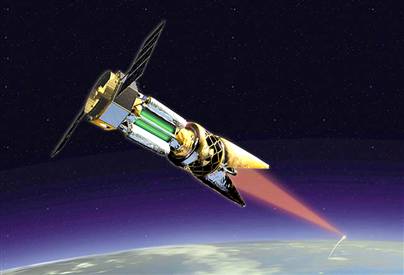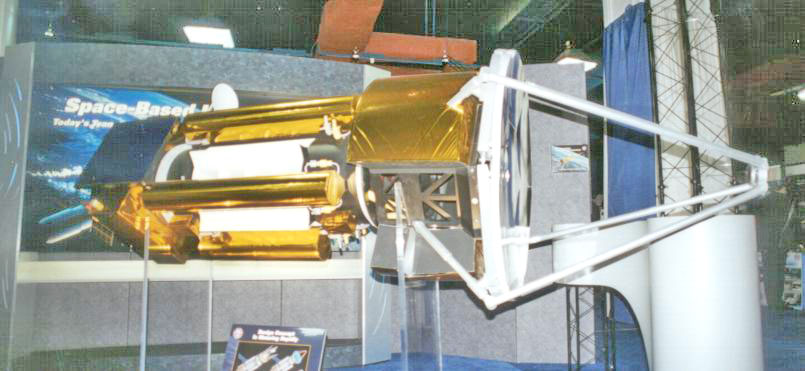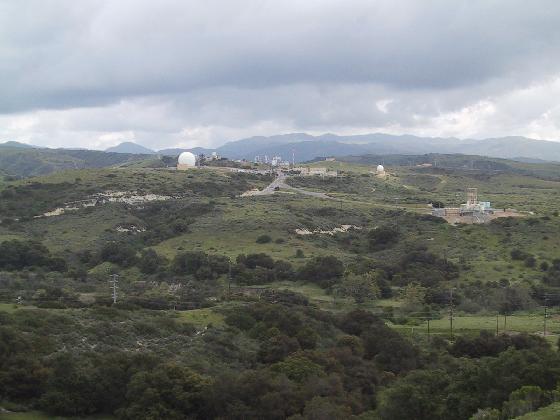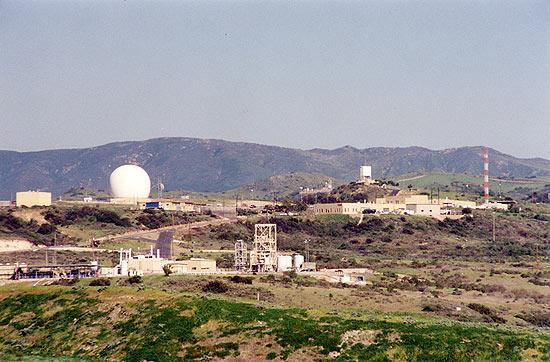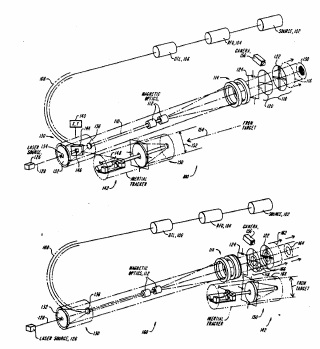|
High Energy Laser System |
||
|
..
SPACE BASED LASER INTEGRATED FLIGHT EXPERIMENT The U.S. Air Force contracted with an industry joint venture on February 08, 1999 for the Space Based Laser Integrated Flight Experiment (SBL IFX). The award constitutes the first increment of a Cost Plus Award Fee/Cost Plus Fixed Fee contract valued at approximately $2-3 billion once completed. The first increment, representing approximately $125M in funding, initiates tasks to be conducted in the first 18-24 months of the effort and immediately undertakes baseline development activities, as well as an affordability and architecture study. The joint venture titled "Team SBL IFX" was formed on February 08, 1999, by LOCKHEED MARTIN CORPORATION, acting through Lockheed Martin Missiles and Space in Sunnyvale California, THE BOEING COMPANY, acting through its Canoga Park California offices and TRW INC., acting through its Space and Electronics Group in El Segundo California. The SBL IFX program is executed by the U.S. Air Force’s Space and Missile Systems Center (SMC) in Los Angeles California for the Ballistic Missile Defense Office. The program is jointly funded by the U.S. Air Force and the Ballistic Missile Defense Organization. The program’s objective is to conduct a research effort to advance and assess the feasibility of the Space Based Laser (SBL) concept and its technologies, culminating in an SBL ballistic missile defense (BMD) demonstration in space, as well as an assessment of non-BMD mission utility. The SBL IFX program will include ground, flight, and space experiments as needed to verify technologies at the component and subsystem level to support design activities for the building of a SBL IFX flight vehicle. This sub-scale flight vehicle will serve as a space test bed for the technologies. More importantly, it provides a focal point for resolving the integration challenges embodied in creating a system that unites precision optics and high energy lasers onto a lightweight spacecraft. Thorough end-to-end ground testing of the vehicle will be conducted prior to flight to create a data base for analyzing on-orbit performance. If the SBL IFX effort proves successful, the Department of Defense will assess the cost and utility of an operational system, as well as the threat predictions, to decide whether to actually enter the acquisition process for the development of an operational capability. These pages created and maintained by (Last Updated 9 Feb 99): SMC/ADE
SOURCE: FAS.org Related Links:
|
||
|
..
Description: The Capistrano Test Site is a remote, 2,700 acre R&D complex in the hills at the edge of Camp Pendleton, operated by TRW's Defense Space Systems Group. It was built up dramatically to support space-based "Star Wars" weapons systems in the 1980's, and is still at work on advanced and powerful chemical laser systems, as well as, radar, and propulsion systems. Location: San Clemente
LCS: Aerospace R&D, R&D
SOURCE: TRW Capistrano Test Site |
||
|
Lockheed Martin, TRW Complete
First Integrated Test of Space Laser Components
Monday, March 17, 1997 10:02:00 AM EST REDONDO BEACH, Calif.--(BUSINESS WIRE)--March 17, 1997--On Feb. 20, Lockheed Martin and TRW NYSE:TRW) moved the nation one step closer to being able to demonstrate a space-based laser (SBL) missile defense system. Working together at TRW's Capistrano Test Site near San Clemente, Calif., the two companies successfully completed the first integrated ground test of the high-power laser and optical subsystems required for a prototype SBL system. The test involved generating a megawatt-class chemical laser beam, then feeding it through a 4-meter diameter beam expander and beam projection system. High-energy lasers on orbiting space platforms may one day be used to destroy ballistic missiles in their boost phase from thousands of kilometers away. The test, which lasted approximately one-half second, ran for its full planned duration. It was conducted in a special test chamber that simulates the vacuum of space. The test marked the first time that the TRW-built Alpha chemical laser had been fed through the Large Advanced Mirror Program (LAMP) beam projection telescope, and the Large Optics Demonstration Experiment beam control system developed by Lockheed Martin. The test was performed as part of the Alpha LAMP Integration (ALI) program, an SBL technology development effort sponsored by the Ballistic Missile Defense Organization (BMDO). "We are delighted with the success of this first integrated test of SBL components," said Dr. Raymond S. Colladay, Lockheed Martin Astronautics president. "The test begins the validation of the ALI system design and provides a very encouraging step toward demonstrating the technical feasibility of a space-based laser defense system." Results from the February test will be used to develop the test plan for a more comprehensive ALI test later this spring, he added. Dr. Noel Hinners, vice president, Lockheed Martin Astronautics Flight Systems, commented, "This successful test is a significant milestone on the nation's path toward developing options for a national missile defense capability." Added Joanne Maguire, vice president and general manager, TRW Space & Technology Division: "The successful ALI test represents another step in BMDO's systematic approach for developing, maturing and integrating the technologies required for a space-based laser. As the nation's leading developer and supplier of high-energy lasers for critical defense applications, TRW is pleased to contribute to the progress being made on this important program." During this first ALI test, known as an "open loop" test, the beam control system was "on" but not used in its fully operational mode: Its sensors could "see" the Alpha laser beam, but its deformable and fast steering mirrors were not commanded to "shape" the beam to compensate for environmental factors that would degrade the beam's effectiveness. Future "closed loop" ALI tests will use the beam control system in its fully operational mode. Alpha is a high-energy, space-compatible, hydrogen fluoride laser developed by TRW for the Department of Defense in the early 1980s. In 12 previous Alpha tests at the Capistrano test facility, TRW has demonstrated laser technologies considered critical to the development and production of an SBL missile defense system. The most recent test occurred in September 1996 as part of TRW's current $30 million Alpha Laser Optimization contract with BMDO. TRW Space & Electronics Group (S&EG), an operating unit of Cleveland-based TRW Inc., has been engaged in the research and development of lasers since 1961. Today, the group designs and develops a variety of high-energy chemical lasers for space, ground and airborne applications, including hydrogen fluoride, deuterium fluoride, and chemical oxygen iodine lasers. S&EG also produces solid-state lasers for military and industrial applications. TRW Inc. provides advanced technology products and services for the automotive, space and defense, and civil systems markets worldwide. Its 1996 sales totaled $9.86 billion. Astronautics is one of four operating units of Lockheed Martin's Space & Strategic Missiles Sector headquartered in Bethesda, Md. Astronautics designs, develops, tests and manufactures a variety of advanced technology systems for space and defense. Its chief products include planetary spacecraft and other space systems, space launch systems and ground systems. Business Wire. All rights reserved. SOURCE: Fas.org |
||
| Title: Laser Options for National
Missile Defense
Subject: A technical, operational, fiscal, and political trade between potential national ballistic missile defense laser architectures. Author(s): Steven G. Leonard; Mark L. Devirgilio (Faculty Advisor) DTIC Keywords: LASER MIRRORS, LASER TARGETS, LASER WEAPONS, SPACE BASED, SPACE SYSTEMS, SPACE TO SPACE, SPACE TO SURFACE, SPACE WARFARE, SPACE WEAPONS Abstract: The Cold War threat that was characterized by a USSR launch of a large number of ballistic missiles towards the United States has been replaced today by an even less stable ballistic missile security environment. The US National Security Strategy recognizes the existence of threats with both the capability and will to use weapons of mass destruction launched by ballistic missiles. This threat environment coupled with a high leverage to attack ballistic missiles in the boost phase, points to a National Missile Defense (NMD) solution that includes laser weapons. Four boost-phase laser architectures have been evaluated using NMD technical, operational, fiscal and political criteria. The Space Based Laser (SBL), SBL with Relay Mirrors, Ground Based Laser (GBL) with Relay Mirrors, and Airborne Laser (ABL) with Relay Mirrors each meet the NMD requirements with varying degrees of success. Overall, a Relay Mirror architecture accepting multiple laser sources was found to produce the best NMD boost-phase defense while reducing potential technical, operational, and political issues. This analysis shows that US Space Command should implement a Relay Mirror architecture with the ability to accept multiple laser sources, such as the planned ABL or a future GBL. This would enable a powerful boost-phase NMD capability with future expandability at minimal cost. Improvements to this architecture could be implemented using SBL, GBL, or ABL sources as NMD or adjunct mission requirements increase. |
||
| Rapid re-targeting, space-based,
boresight alignment system and method for neutral particle beams
Publication number: US5166745
Abstract of US5166745
Apparatus and method are disclosed enabling to register
vectors respectively representative of directed energy pointing direction
and targeted object pointing direction to allow rapid re-targeting boresight
alignment transfer of a space-based neutral particle beam to targeted ballistic
missile trajectories independently of relative reference frame vector measurement
uncertainty arising from platform vibration and, among other things, space-noise.
|
||
| Team SBL-IFX Uses Alpha Laser
Test to Refine Design Tools, Reduce Size, Weight and Cost for Space-Based
Laser
Business Editors REDONDO BEACH, Calif.--(BUSINESS WIRE)--Nov. 14, 2000--Team SBL-IFX, a joint venture comprising TRW (NYSE:TRW), Lockheed Martin and Boeing, is using results from a recent test of the TRW-built Alpha chemical laser to validate and refine the software models being used to design and predict the performance of the high-energy laser required for an experimental space-based missile defense system proposed by the Air Force and the Ballistic Missile Defense Organization. The test is the latest in a string of successes the team has had in reducing the potential size, weight and cost of the Space-Based Laser Integrated Flight Experiment (SBL-IFX), expected to be launched in 2012. The six-second test of the megawatt-class Alpha was conducted Oct. 12 at TRW's Capistrano Test Site in Southern California. It demonstrated that discrete variations in the laser's chemical flow rates could be used to tailor the laser's chemical efficiency and output power, and the uniformity of its beam. The test also validated a new diagnostic tool used to calculate the laser's output power during testing. "Being able to test our SBL-IFX laser predictions using a real high-energy laser test bed such as Alpha is a real bonus," said Col. Neil McCasland, director of the Air Force's SBL-IFX project. "The more we understand about laser performance under different operating conditions, the more accurately we can design and produce a laser that's optimized for the size, weight and performance requirements of the SBL-IFX mission." Team SBL-IFX conducted the Alpha test as part of its $240 million development contract with the Air Force and the Ballistic Missile Defense Organization. The SBL-IFX project will use a cylindrical, hydrogen-fluoride chemical laser like Alpha as its baseline, but will take advantage of engineering advances in the design and fabrication of laser hardware since Alpha was designed in the mid-1980s. According to Dan Wildt, TRW's SBL-IFX program manager, the demonstrated relationships between chemical flow rates and laser performance are encouraging. "This test has helped us validate ways to increase the chemical efficiency of the laser, which will translate directly into reductions in the size and weight of chemical storage tanks required to support a given mission requirement," he explained. Chemical efficiency is a measure of the laser's ability to extract energy from a controlled chemical reaction. The more efficient the laser, the more power it can produce per unit weight of chemical reactants. The Alpha test follows several other recent developments by Team SBL-IFX that will reduce the SBL-IFX laser's size, weight and cost, and enhance its performance. The list of successes includes:
Team SBL-IFX's risk-reduction activities are focused on maturing the component technologies required to produce, integrate and perform a ground-based demonstration of a full-scale SBL-IFX integrated test unit before the end of the decade. The objective of the SBL-IFX project is a lethal, on-orbit demonstration of SBL-IFX's defensive capabilities against a live, boosting missile target, expected in 2013 Team SBL-IFX comprises TRW Space & Electronics Group, Redondo Beach, Calif.; Lockheed Martin Missiles & Space Operations, Sunnyvale, Calif.; and Boeing Space & Communications Group, Seal Beach, Calif. |
||
| FAIR USE NOTICE: This page contains copyrighted material the use of which has not been specifically authorized by the copyright owner. Pegasus Research Consortium distributes this material without profit to those who have expressed a prior interest in receiving the included information for research and educational purposes. We believe this constitutes a fair use of any such copyrighted material as provided for in 17 U.S.C § 107. If you wish to use copyrighted material from this site for purposes of your own that go beyond fair use, you must obtain permission from the copyright owner. | ||
|
|
